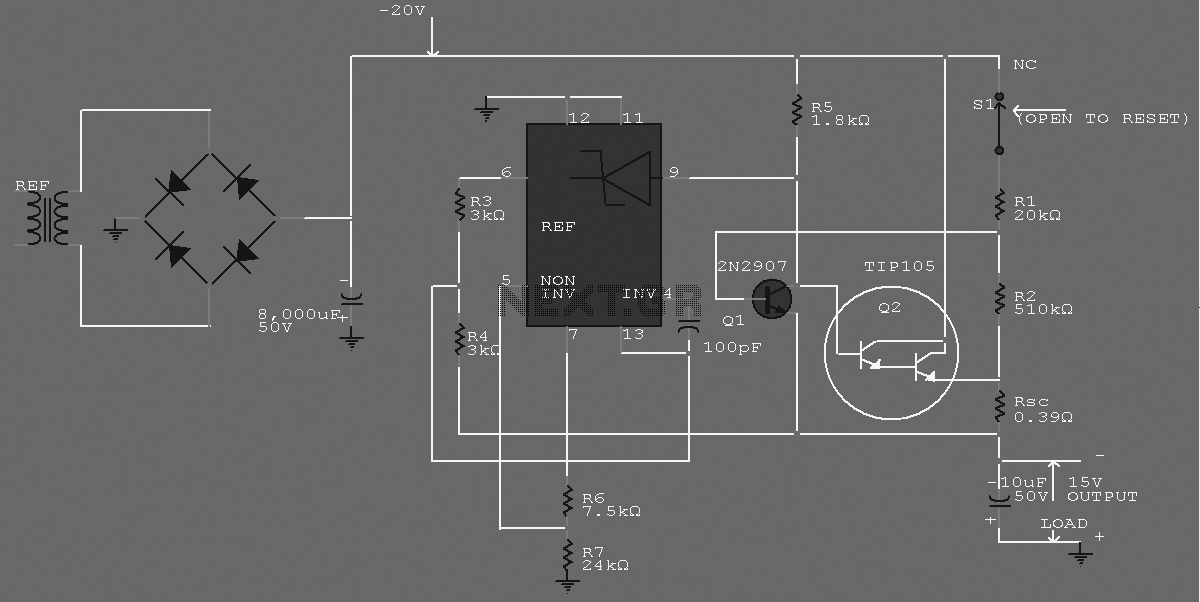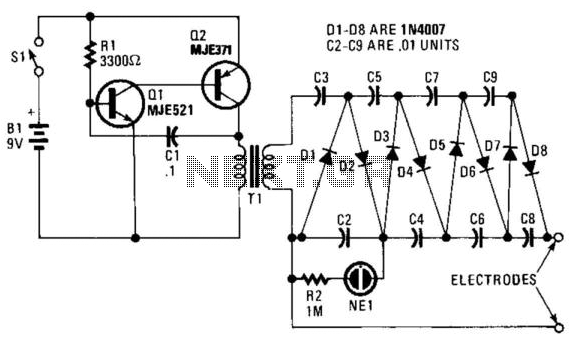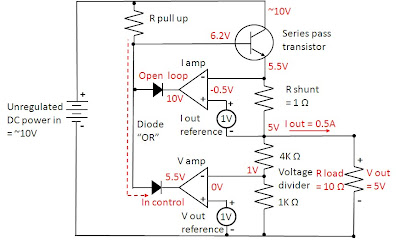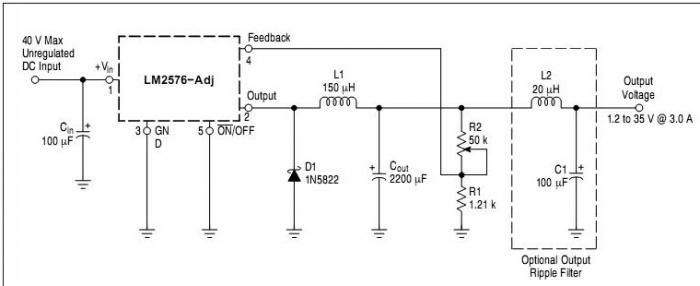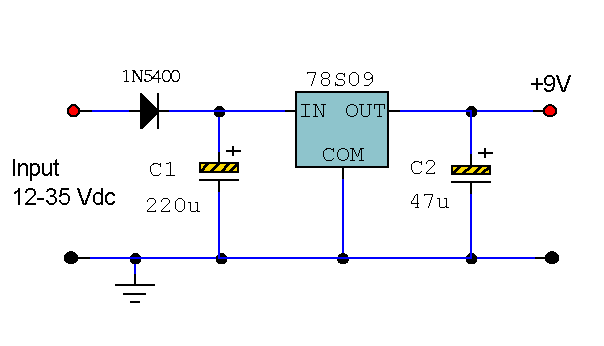
RFI-Free Ringer Generator Works Off Single 5-V Supply

A simple yet effective circuit to generate a POTS-compatible ringing voltage can be constructed using National Semiconductor's LM4871 audio amplifier IC along with a dozen passive components. This circuit produces a sine-wave output of 1 W at approximately 70 V rms, which is adequate for powering most standard telephone ringers. The op-amp section of the LM4871 (pins 3, 4, and 5) is configured as an inverting gain stage. This stage operates as a sine-wave oscillator due to a phase-shift network composed of resistors R1, R2, and R3, along with capacitors C1, C2, and C3. The non-inverting input is biased using the built-in rail splitter on pin 2, with R3 also serving as the input resistor. Consequently, the gain is determined by the ratio of feedback resistor R4 to R3. The specified values balance waveform purity and stable oscillation. Ceramic capacitor C4 mitigates the LM4871's tendency to enter spurious high-frequency oscillation at certain output voltages. Bypass capacitors C5 and C6 are low-cost, solid-tantalum types. Transformer T1 can be a standard 60-Hz power transformer, such as the Triad FS12-500, designed to provide 6.3 V rms at 600 mA or more from a 220- to 240-V source. Derating factors for sub-design frequency operation have been considered. The circuit oscillates at approximately 20 Hz, which can be adjusted to about 25 Hz by reducing the values of resistors R1, R2, and R3 to 24.3 kΩ, and R4 to 845 kΩ. Although conventional mechanical ringers create a resonant circuit with their blocking capacitor, frequency is not highly critical in most ringer applications. To accommodate devices that accept both 20 Hz and 25 Hz standards, the oscillator can be set to 22.5 Hz by using R1, R2, and R3 at 27.4 kΩ and R4 at 953 kΩ, ensuring adequate frequency stability with inexpensive 10% tolerance polyester capacitors for C1, C2, and C3. The timing of the ringing voltage burst can be conveniently controlled by applying a 5-V CMOS-level pulse to the Enable input. When this input is driven high (or left open), the LM4871 enters a shutdown mode, resulting in a total current drain of less than 1 µA. When the input is pulled below 0.5 V, the oscillator starts smoothly, achieving full amplitude within 300 ms. Typically, the start time is not a significant concern, as ringing bursts usually last at least one second.
The circuit design leverages the LM4871's capabilities to generate a robust ringing voltage suitable for POTS (Plain Old Telephone Service) applications. The configuration of the op-amp as an inverting gain stage allows for effective sine-wave generation through the phase-shift network, which is critical for producing the desired ringing tone. The choice of passive components, particularly the resistors and capacitors, plays a vital role in determining the oscillation frequency and waveform characteristics. The use of ceramic capacitors for stability and tantalum capacitors for bypassing ensures reliable operation and minimizes noise interference.
The transformer selection is also crucial, as it must provide adequate voltage and current without saturation, particularly under load conditions typical of telephone ringers. The design accommodates variations in frequency, allowing for flexibility in applications that may require different ringing frequencies. The ability to control the ringing bursts through a CMOS-level pulse enables integration with digital systems, enhancing the circuit's versatility.
Overall, this circuit exemplifies a practical approach to generating ringing voltage for telephone systems, balancing simplicity and effectiveness while ensuring compliance with industry standards. The detailed specifications of component values and configurations provide a clear framework for implementation, making it accessible for engineers and technicians in the field.A simple yet effective circuit to generate a POTS-compatible ringing voltage can be made from National Semiconductor`s LM4871 audio-amplifier IC and a dozen passive components ( see the figure ). This circuit delivers 1 W of sine-wave output at about 70 V rms. This is sufficient to power most ordinary telephone ringers. The op-amp section of the L M4871 (pins 3, 4, and 5) is connected as an inverting gain stage. The stage functions as a sine-wave oscillator thanks to the phase-shift network, which consists of resistors R1, R2, and R3; and capacitors C1, C2, and C3. The noninverting input is biased by the built-in rail splitter on pin 2, and R3 doubles as the input resistor.
Therefore, the ratio of feedback resistor R4 to R3 determines gain. The values shown represent a compromise between waveform purity and robust oscillation. Ceramic capacitor C4 counteracts the LM4871`s tendency to break into spurious high-frequency oscillation at certain output voltages. Bypass capacitors C5 and C6 are inexpensive, solid-tantalum types. T1 can be an ordinary, off-the-shelf, 60-Hz power transformer, such as the Triad FS12-500, designed to yield 6.
3 V rms at 600 mA or more from a 220- to 240-V source. The derating factors appropriate for sub-design-frequency operation have been applied. As shown, the circuit oscillates at approximately 20 Hz. It can be retuned to about 25 Hz by scaling resistors R1, R2, and R3 down to 24. 3 k ©; and R4 to 845 k ©. Although a conventional mechanical ringer forms a resonant circuit with its blocking capacitor, frequency isn`t extremely critical in most ringer applications. To signal devices that accept both the 20- and 25-Hz standards, the oscillator may be designed for 22.
5 Hz (R1, R2, and R3 at 27. 4 k © and R4 at 953 k ©), permitting adequate frequency stability using inexpensive, 10% tolerance, polyester capacitors for C1, C2, and C3. The ringing-voltage burst timing is conveniently controlled by applying a 5-V CMOS-level pulse to the Enable input.
If this input is driven high (or left open), the LM4871 shuts down so that the circuit`s total current drain is under 1 µA. When the input is pulled below 0. 5 V, the oscillator starts smoothly, reaching full amplitude in 300 ms. Usually the start time isn`t much of an issue because ringing bursts typically last at least one second.
🔗 External reference
The circuit design leverages the LM4871's capabilities to generate a robust ringing voltage suitable for POTS (Plain Old Telephone Service) applications. The configuration of the op-amp as an inverting gain stage allows for effective sine-wave generation through the phase-shift network, which is critical for producing the desired ringing tone. The choice of passive components, particularly the resistors and capacitors, plays a vital role in determining the oscillation frequency and waveform characteristics. The use of ceramic capacitors for stability and tantalum capacitors for bypassing ensures reliable operation and minimizes noise interference.
The transformer selection is also crucial, as it must provide adequate voltage and current without saturation, particularly under load conditions typical of telephone ringers. The design accommodates variations in frequency, allowing for flexibility in applications that may require different ringing frequencies. The ability to control the ringing bursts through a CMOS-level pulse enables integration with digital systems, enhancing the circuit's versatility.
Overall, this circuit exemplifies a practical approach to generating ringing voltage for telephone systems, balancing simplicity and effectiveness while ensuring compliance with industry standards. The detailed specifications of component values and configurations provide a clear framework for implementation, making it accessible for engineers and technicians in the field.A simple yet effective circuit to generate a POTS-compatible ringing voltage can be made from National Semiconductor`s LM4871 audio-amplifier IC and a dozen passive components ( see the figure ). This circuit delivers 1 W of sine-wave output at about 70 V rms. This is sufficient to power most ordinary telephone ringers. The op-amp section of the L M4871 (pins 3, 4, and 5) is connected as an inverting gain stage. The stage functions as a sine-wave oscillator thanks to the phase-shift network, which consists of resistors R1, R2, and R3; and capacitors C1, C2, and C3. The noninverting input is biased by the built-in rail splitter on pin 2, and R3 doubles as the input resistor.
Therefore, the ratio of feedback resistor R4 to R3 determines gain. The values shown represent a compromise between waveform purity and robust oscillation. Ceramic capacitor C4 counteracts the LM4871`s tendency to break into spurious high-frequency oscillation at certain output voltages. Bypass capacitors C5 and C6 are inexpensive, solid-tantalum types. T1 can be an ordinary, off-the-shelf, 60-Hz power transformer, such as the Triad FS12-500, designed to yield 6.
3 V rms at 600 mA or more from a 220- to 240-V source. The derating factors appropriate for sub-design-frequency operation have been applied. As shown, the circuit oscillates at approximately 20 Hz. It can be retuned to about 25 Hz by scaling resistors R1, R2, and R3 down to 24. 3 k ©; and R4 to 845 k ©. Although a conventional mechanical ringer forms a resonant circuit with its blocking capacitor, frequency isn`t extremely critical in most ringer applications. To signal devices that accept both the 20- and 25-Hz standards, the oscillator may be designed for 22.
5 Hz (R1, R2, and R3 at 27. 4 k © and R4 at 953 k ©), permitting adequate frequency stability using inexpensive, 10% tolerance, polyester capacitors for C1, C2, and C3. The ringing-voltage burst timing is conveniently controlled by applying a 5-V CMOS-level pulse to the Enable input.
If this input is driven high (or left open), the LM4871 shuts down so that the circuit`s total current drain is under 1 µA. When the input is pulled below 0. 5 V, the oscillator starts smoothly, reaching full amplitude in 300 ms. Usually the start time isn`t much of an issue because ringing bursts typically last at least one second.
🔗 External reference
